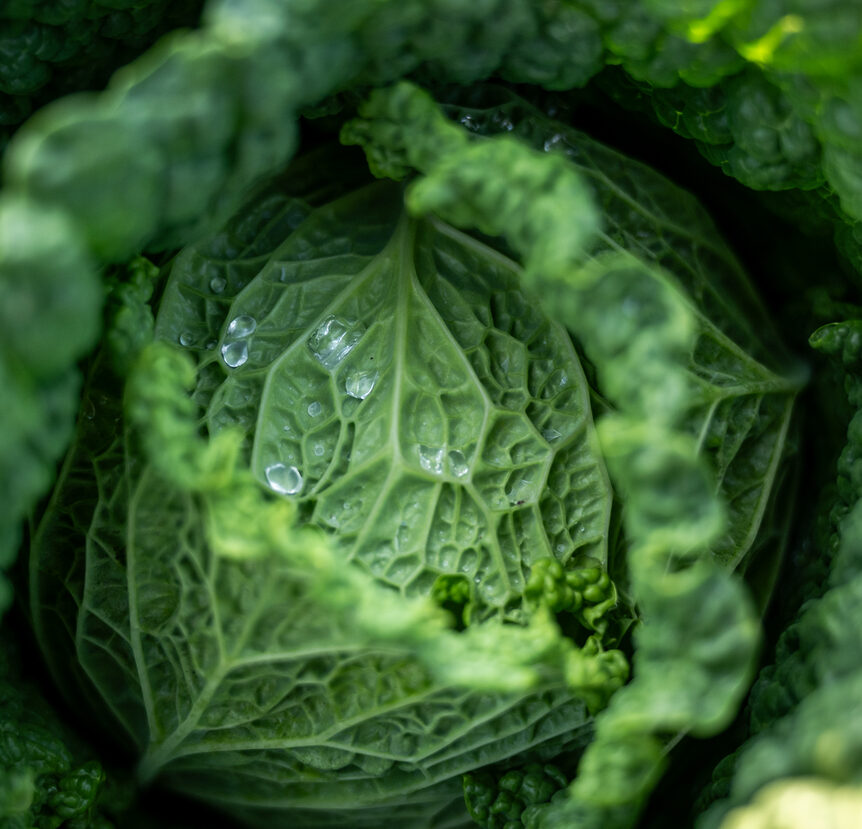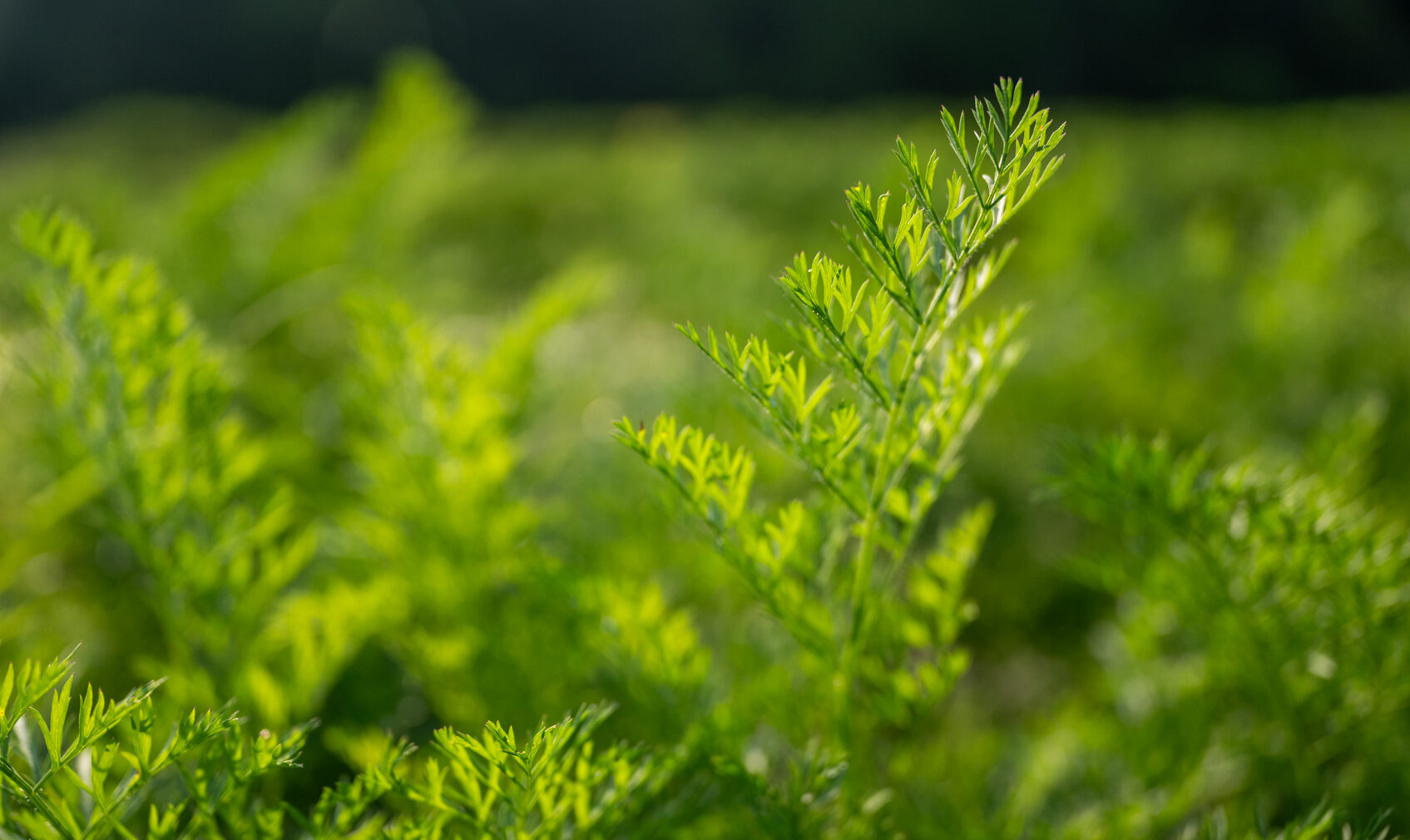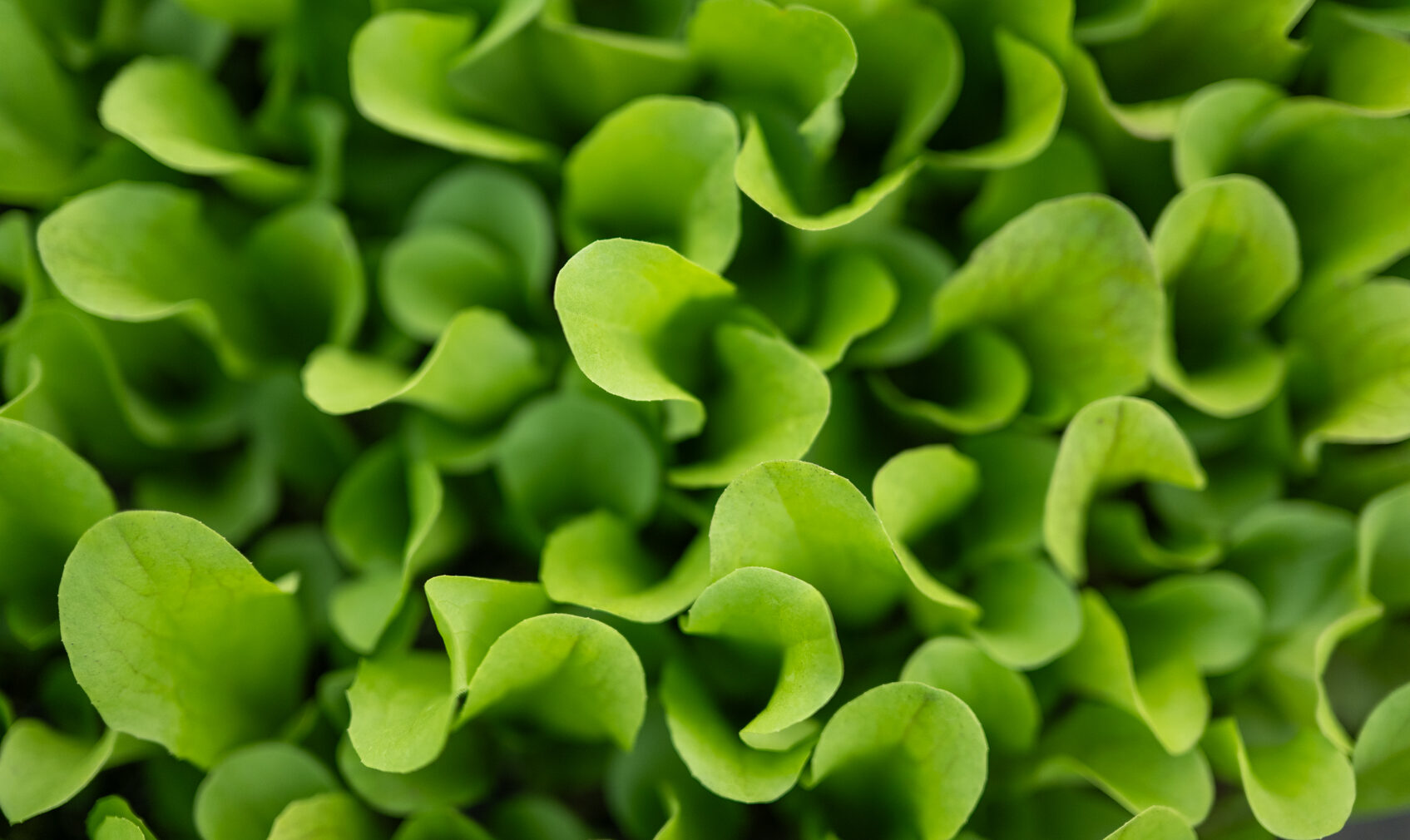Level 1 in a nutshell:

Complete Photosynthesis
Plants increase both the quantity of sugars the produce through photosynthesis, by as much as 3-4x, and their quality.

Disease resistance
Plants resist soil-borne fungal pathogens, including:
• verticillium
• fusarium
• rhizoctonia
• pythium
• phytophthora (not actually a fungus, for all you sticklers out there)

Minerals Required
The 5 minerals that are needed for the photosynthetic process:
• Magnesium
• Iron
• Manganese
• Nitrogen
• Phosphorus
“What we have come to accept as ‘normal’ is plants which are photosynthesizing at only 25% of their inherent genetic capacity”
Dive Deeper into Level 1
Complete Photosynthesis
Complete photosynthesis has 2 components: quantity and quality.
Plants that can photosynthesize completely are able to increase the total volume of sugars that they produce in a 24-hour period, sometimes by as much as 3-4x. This can be measured in a laboratory, but in the field, you can get a rough idea by reading brix on a refractometer. It is not unusual to see a plant’s brix reading increase from around 3-5 to around 12-15 or even higher when it is photosynthesizing properly.
In addition to producing more sugars, plants at Level 1 also produce higher quality sugars. These plants have very low levels of simple, non-reducing sugars; each simple sugar molecule, like glucose or fructose, is quickly changed into a complex carbohydrate.Disease Resistance
The mechanism for a plant’s resistance has to do with the quality of the plant’s carbohydrate profile, the ratio of reducing to non-reducing sugars, and thus the quality of the root exudates it feeds into the soil. This determines the microbial profile in the rhizosphere, and whether the soils become disease-suppressive or disease-enhancing.
Required Minerals
To reach Level 1 of plant health, plants require 5 minerals, all of which are needed for the photosynthetic process:
• Magnesium
• Nitrogen
• Iron
• Manganese
• Phosphorus
Magnesium and Nitrogen are critical components of the chlorophyll molecule itself. Iron is needed to assemble chlorophyll. And Manganese is required for water hydrolysis–the splitting of H20 into H and OH–which is the very first step in photosynthesis.
Phosphorus isn’t directly involved in photosynthesis, but it is the essential element in ATP, which is needed in large quantities to metabolize the bounty of sugars that are created through high-functioning photosynthesis.
So, if plants have adequate levels of the 5 elements Mg, Fe, Mn, N, and P, they can reach Level 1 of plant health. As a grower, you don’t necessarily need to add these elements, you just need to make sure your plants have enough. At AEA we have found that iron and manganese almost always need to be added–these two elements oxidize very easily, so even when they’re amply present in soils, they tend not to be available to plants.
Attaining Level 1 of plant health is critical–everything that happens in levels 2, 3, and 4 has the prerequisite of complete photosynthesis. It should be noted that Level 1 is not the baseline–reaching it is quite an achievement in itself. John Kempf has observed most agricultural crops to be at the equivalent of a Level 0 or even -1.
Certain AEA products can supply the needed elements for Level 1: MacroPak and MicroPak make a great combination: MicroPak supplies Fe and Mn, and MacroPak has N, P, and Mg.
Level 2 in a nutshell:

Complete Protein Synthesis
All the forms of nitrogen the plant absorbs–ammonium, urea, nitrates, or amino acids–are quickly converted into complete proteins.

Insect resistance
Plants resist insects with the simplest digestive systems–the larval and sucking insects–including:
• tomato hornworm
• cabbage loopers
• aphids
• white flies
• thrips

Minerals Required
The 4 minerals that are needed for nitrogen synthesis and pest resistance:
• Magnesium
• Sulfur
• Molybdenum
• Boron
Dive Deeper into Level 2
Complete Protein Synthesis
In Level 2, plants synthesize complete proteins. That means that all the forms of nitrogen the plant absorbs–ammonium, urea, nitrates, or amino acids–are quickly converted into complete proteins. This process can be validated by plant sap analysis: nitrate and ammonium levels will appear as 0 on the sap test, but the plant will have abundant levels of total N.
Insect Resistance
Plants achieve resistance to larval and sucking insects by what is referred to as passive immunity. While active immunity is achieved through production of immune compounds, passive immunity simply involves removing the pest’s food source. In this case, these larval and sucking insects feed on soluble nitrates. They cannot digest complete proteins. When the plant is quickly converting all its soluble nitrates into complete proteins, there is no food in its sap for these types of insects, and they will seek other, less healthy, plants to feed on.
Plants in Level 2 can also resist pests like spider mites and thrips that are attracted to high levels of ammonium. We tend to think of these pests as occurring at high temperatures. In fact it’s not the temperature, but the ammonium that shows up at high temperatures that the insects respond to.Required Minerals
Reaching Level 2 of plant health requires the plant to have adequate levels of four minerals: Magnesium, Sulfur, Molybdenum, and Boron.
The first three (Mg, S, and Mo) are all needed for nitrogen synthesis, that is, creating complex proteins out of simple sources of nitrogen. This is how we get nitrate levels to 0 while still having abundant total N.
Boron isn’t directly involved in nitrogen synthesis, but does contribute significantly to pest resistance.
The incredible thing about Level 2 is that plants can begin synthesizing proteins immediately when they have adequate levels of these minerals, meaning that insect resistance can manifest within 24-48 hours of these minerals being applied. Essentially, the insect’s food source is removed, and there is no longer anything for them to feed on.
Balanced Chemistry
While Levels 1 and 2 each involve different physiological processes within the plant and require different minerals to reach, in the field they often can happen at the same time. They are both achieved through chemical solutions, so if all 8 of the required minerals for the 2 levels are supplied in appropriate amounts, the plant can leap from Level 0 right to Level 2.
Levels 1 and 2 involve passive immunity: by removing the pest’s food source, they remove any incentive for the pests to bother the plants. By contrast, levels 3 and 4 develop pest and disease resistance through active immunity: they activate the plant’s immune system and physical defenses so it can defend itself against attacking pests.
The first two levels are achieved simply by balanced chemistry within the plant, but levels 3 and 4 are more advanced because they depend on soil biology.
For these two reasons, there is a gap between levels 2 and 3. From a management perspective, the grower must focus their attention on creating thriving soil biology.
Level 3 in a nutshell:

Lipid Synthesis
In level 3, plants produce so much energy that they have a surplus. Just like humans, plants store their surplus energy as fat. Plants at level 3 see at 2-4x increase in lipid synthesis.

Disease resistance
Plants resist airborne pathogens, including:
• downy mildew
• powdery mildew
• fire blight
• rust

Microbial metabolites
To reach this stage of health, plants must absorb the majority of their nutrition from soil microbes.
“In regenerative agriculture, we don’t just grow plants; we nurture ecosystems.”
Dive Deeper into Level 3
Lipid Synthesis
In level 3, plants produce so much energy that they have a surplus. Just like humans, plants store their surplus energy as fat. Plants at level 3 see at 2-4x increase in lipid synthesis. To get specific, plants before this level have a lipid concentration of 1.5-2% (on a dry matter basis). Plants at level 3 have lipid concentrations of 4-6%.
And just like humans, plants find a place in their bodies to store the fat. Since plants don’t have the handy fat storage containers of thighs, hips, and bellies that humans have, they find somewhere else to store fat: their leaves. Plants at level 3 will have glossy or waxy leaves on account of the fat stored on their surfaces.Disease Resistance
That waxy layer on the leaves actually serves a critical function for the plant’s immune system: it becomes an impenetrable shield that prevents airborne pathogens–both fungal and bacterial–from infecting the plant when they land on its leaves.
These pathogens work by using a pectolytic enzyme to break down pectins in the cell membrane, which allows them to invade the cell and use it as an energy source. The waxes on the leaf’s surface prevent that enzyme from working, so the pathogens are unable to enter the plant’s cells and cause an infection.Microbial Metabolites
To reach this stage of health, plants must absorb the majority of their nutrition from soil microbes. The microbial metabolites produced in the soil tend to be more complex forms of nutrition, which means that the plant doesn’t need to spend any energy converting simple forms of nutrition into those more complex forms.
For example, when corn absorbs 80% of its nitrogen in the from of nitrate, it uses 16% of its total energy supply just converting that nitrate into amino acids. But soil microbes can create whole amino acids. If the plant instead absorbs its nitrogen as microbe-produced amino acids, that means 16% of its energy is freed up for other uses. When it has enough excess energy, it starts storing it as fat, and Level 3 begins.
Plants are capable of absorbing relatively complex compounds from the soil profile. John Kempf calls these “prefabricated parts,” and they save the plant a tremendous amount of energy.
Level 4 in a nutshell:

Elevated Levels of Plant Secondary Metabolites
These are compounds that plants create to protect themselves, which have incredibly powerful anti-bacterial and anti-fungal properties.

Insect resistance
Such pests as:
• beetles
• stink bugs
• nematodes

Diverse Microbiome
The right microbes will trigger the plant’s immune response, (both systemic acquired resistance (SAR) and induced systemic resistance (ISR)).
Dive Deeper into Level 4
Elevated Levels of Plant Secondary Metabolites
The hallmark of level 4 is that plants produce elevated levels of plant secondary metabolites. These are compounds that plants create to protect themselves, like flavanols, phytoalexins, and biflavonoids. We’re familiar with many of these compounds, because humans make use of their powerful properties in medicine and recreation. They include caffeine, nicotine, morphine, quinine, neem, THC, tannins, etc.
Many of these compounds have incredibly powerful anti-bacterial and anti-fungal properties. They can help protect the plant from UV light in addition to insects and diseases. They are also energy-intensive to produce, so the plant must have passed through the previous 3 levels of health to have enough energy to devote to making a lot more of these compounds than is considered normal.Insect resistance
In level 4, plants become resistant to chewing insects, including the entire beetle family:
• Japanese beetles
• corn earworm beetles
• squash bugs
• colorado potato beetles
• brown marmorated stink bugs
They also can resist nematodes, like root rot nematodes.
Plants at level 4 may even be able to resist viruses. It’s been observed that viral expression can become dormant, that is, the virus is present in the plant, but has no physiological effect on it.Diverse Microbiome
Reaching level 4 requires a diverse and abundant microbiome, both above and below ground. The right microbes will trigger the plant’s immune response, (both systemic acquired resistance (SAR) and induced systemic resistance (ISR)), and induce the plant to create secondary metabolites at much higher levels. It’s important that the microbiome contains the correct microbes, that is, disease-suppressive rather than disease-enhancing microbes, in order to get this level of immune response.
Certain microbial products, like soil-applied Spectrum and foliar-applied Micro5000, contain species of microbes that may trigger these immune responses. Other applied products like chitin, seaweed, and fulvic acid can also help trigger the plant’s immune response.
Conclusion
It is possible for plants to resist diseases and insects. This isn’t some pipedream, but a systematic process that can be managed on the farm by thoughtful growers. By tackling the levels of the Plant Health Pyramid one at a time, growers can lead their plants into higher levels of health and pest resistance, reducing their need for pesticides and outside inputs, while also growing healthier food and contributing to healthier ecosystems. It’s win-win-win. That’s the true definition of regeneration: a rising tide that lifts all boats.

Download the Infographic
Our Plant Health Pyramid infographic distills all this information onto a 2-sided piece of paper.







